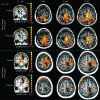Complex versus simple ankle movement training in stroke using telerehabilitation: a randomized controlled trial
- PMID: 22095209
- PMCID: PMC3269771
- DOI: 10.2522/ptj.20110018
Complex versus simple ankle movement training in stroke using telerehabilitation: a randomized controlled trial
Abstract
Background: Telerehabilitation allows rehabilitative training to continue remotely after discharge from acute care and can include complex tasks known to create rich conditions for neural change.
Objectives: The purposes of this study were: (1) to explore the feasibility of using telerehabilitation to improve ankle dorsiflexion during the swing phase of gait in people with stroke and (2) to compare complex versus simple movements of the ankle in promoting behavioral change and brain reorganization.
Design: This study was a pilot randomized controlled trial.
Setting: Training was done in the participant's home. Testing was done in separate research labs involving functional magnetic resonance imaging (fMRI) and multi-camera gait analysis.
Patients: Sixteen participants with chronic stroke and impaired ankle dorsiflexion were assigned randomly to receive 4 weeks of telerehabilitation of the paretic ankle.
Intervention: Participants received either computerized complex movement training (track group) or simple movement training (move group).
Measurements: Behavioral changes were measured with the 10-m walk test and gait analysis using a motion capture system. Brain reorganization was measured with ankle tracking during fMRI.
Results: Dorsiflexion during gait was significantly larger in the track group compared with the move group. For fMRI, although the volume, percent volume, and intensity of cortical activation failed to show significant changes, the frequency count of the number of participants showing an increase versus a decrease in these values from pretest to posttest measurements was significantly different between the 2 groups, with the track group decreasing and the move group increasing.
Limitations: Limitations of this study were that no follow-up test was conducted and that a small sample size was used.
Conclusions: The results suggest that telerehabilitation, emphasizing complex task training with the paretic limb, is feasible and can be effective in promoting further dorsiflexion in people with chronic stroke.
Trial registration: ClinicalTrials.gov NCT01298583.
Figures





References
-
- Dobrez D, Heinemann AW, Deutsch A, et al. Impact of Medicare's prospective payment system for inpatient rehabilitation facilities on stroke patient outcomes. Am J Phys Med Rehabil. 2010;89:198–204 - PubMed
-
- Granger CV, Markello SJ, Graham JE, et al. The uniform data system for medical rehabilitation: report of patients with stroke discharged from comprehensive medical programs in 2000–2007. Am J Phys Med Rehabil. 2009;88:961–972 - PubMed
-
- Piron L, Turolla A, Agostini M, et al. Exercises for paretic upper limb after stroke: a combined virtual-reality and telemedicine approach. J Rehabil Med. 2009;41:1016–1102 - PubMed
-
- Carey JR, Durfee WK, Bhatt E, et al. Comparison of finger tracking versus simple movement training via telerehabilitation to alter hand function and cortical reorganization after stroke. Neurorehabil Neural Repair. 2007;21:216–232 - PubMed
-
- Holden MK, Dyar TA, Dayan-Cimadoro L. Telerehabilitation using a virtual environment improves upper extremity function in patients with stroke. IEEE Trans Neural Syst Rehabil Eng 2007;15:36–42 - PubMed
Publication types
MeSH terms
Associated data
Grants and funding
LinkOut - more resources
Full Text Sources
Medical

